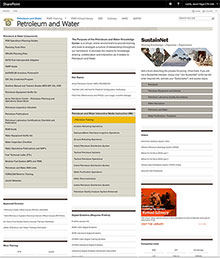Home - Schools & Units - Petroleum Water & Energy Department (PWED)
Petroleum, Water & Energy
Department (PWED)

From our Department Director:
Welcome to the Petroleum, Water and Energy Department. This Department is responsible for instructing all advanced individual training for soldiers and marines in the fields of bulk fuels, petroleum laboratory and water treatment and distribution. We also train officers, reservist and national guard from all services. When the service member can’t come to us, we also provide mobile training teams to units at home station or deployed in the field.
Stewart-Roye Hall is named for two distinguished NCOs; one a Marine and the other a soldier. The name is appropriate as it reflects the partnership the Marine Corps and the Army have in their training of petroleum supply specialists/bulk fuel handlers. This is the only building on Fort Lee named for a marine, again reflecting this partnership. This building is the centerpiece of the petroleum and water complex that includes two major field petroleum areas, two base petroleum laboratories, a mobile and an airmobile petroleum laboratory, four water sites and 28 classrooms.
More than 125 instructors teach in our facilities. Instructors include from the Army, Navy, and Marines; officers; civilians; noncommissioned officers; soldiers, and Marines. Our instructors are highly dedicated and among the most technically competent in the military today.
I am proud to lead this department of America’s finest and am honored to have you visit our web site today. Enjoy your visit and come again.
Mission
- Proponent for Petroleum, Water and Energy training and doctrine
- Conduct resident training:
- 92F Petroleum Supply Specialist (USA, USMC)
- 92L Petroleum Laboratory Specialist (USA, USMC)
- 92W Water Treatment Specialist
- 8A-SIR8, Petroleum & Water Officer Course (PWOC)
- 923A Petroleum Technical Warrant Officer
- 1391 Expeditionary Fuels Technicians (USMC)
- Reserve Component training (USA, USMC, USN)
- Provide responses to the field on all Petroleum, Water and Energy issues
- Develop MOS related materials
PWD History
Events leading to the establishment of extensive petroleum training facilities occurred in the early stages of World War Ⅱ. Petroleum products required by the military prior to the war were relatively small and requirements were usually placed on industry. With the overnight growth of mechanized forces and extensive Air Force training programs Class Ⅲ support became a major logistical problem. Sixty (60%) percent of all cargoes handled were petroleum.
Trained personnel for the military were practically nonexistent and facilities for training were not available. With the loss of so many engines due to the lack of quality fuel, the Army learned a valuable lesson, and immediately after WWⅡ, plans were drafted to put the Army into business of training its own quality surveillance specialists.
To alleviate the situation, courses of instruction and facilities were established in the fall 1946 at Caven Point, New Jersey, under the jurisdiction of the New York Quartermaster Petroleum Field Office. The school was primarily staffed with instructors and highly qualified technical personnel from the petroleum fields of the Midwest. In July 1954 the Caven Point installation was phased out, moved to Fort Lee, Virginia, and became the Petroleum Department of the Quartermaster School.
Water treatment training had been conducted under the direction of the Engineer School, Fort Belvoir, Virginia. In 1981, the decision was made to transfer proponency to the Quartermaster School and combine career management fields with petroleum because water was a liquid logistics function. Final transfer was completed in September 1984 and training began at Fort Lee, Virginia. The first Water Purification class under the Quartermaster School graduated 19 December 1984.
Related Links
- U.S. Army Petroleum Center (APC)
- Inquires on QA/QS/Contracting — Army Petroleum Center Help Desk
- National Petroleum Management Association
- Defense Logistics Agency Energy (DLA-E) Homepage
- State & Territorial Environment Protection Agencies (EPA)
- Aviation Safety Office
- TACOM
- usarmy.detroit.peo-cs-css.mbx.pm-paws-pqas-e@army.mil
- Request for Help: 586-282-8027
PQAS-E Help Desk
TACOM Petroleum and Water Help Inquiries
- Army Credentialing Opportunities On-Line (COOL)
- U.S. Air Force Homepage
- U.S. Marine Corps Homepage
- U.S. Navy Homepage


